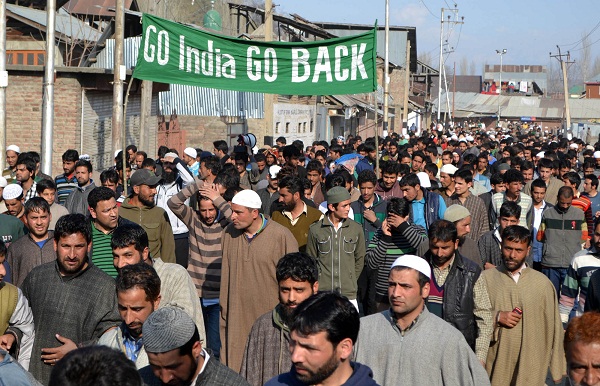“It is an irony of history that by a combination of fortuitous circumstances a tiny nation of Kashmiris has been placed in a position of great importance, where it can be instrumental in making or marring the future of so many.”
– Prem Nath Bazaz (1967)
Hindustan’s partition into Pakistan and India precipitated problems and disputes that would haunt the two newborn countries far into the present, but none so divisive and consequential as the disputed territories of Azad Kashmir and Jammu & Kashmir (J&K)*. Before the partition, Jammu & Kashmir was one of the 562 princely states present in the Indian Subcontinent – relatively autonomous lands that were ruled often as fiefdoms or minuscule principalities. These princely states epitomized the strategy of indirect rule favored and espoused by the British during their colonization of India. It fell upon these principalities to decide to be a part of Muslim-majority Pakistan or Hindu-majority India after the partition; more often than not, however, this decision was already made for them. Jammu & Kashmir was among the princely states where the ruling family did not share the religion of the majority of their people: with a 77% Muslim population, religion was not the only divide between the rulers and their mostly Muslim denizens. There was an economic rift between the Muslims and the richer Hindus and Sikhs that harkened back to medieval feudal inequality.[1] These economic and demographic inequalities have exacerbated the dispute over Kashmir.
The Kashmir conflict – essentially a territorial dispute between Pakistan and India – has resulted in the subjugation of Kashmiri Muslims and other minorities, such as Kashmiri Pandits. Kashmiris have actively mobilized for a commitment towards freedom and independence that has only strengthened over time. Kashmir has been either mistreated or neglected throughout history at the hands of India, Pakistan, and the world: this is a call for a renewed interest in the conflict over Kashmir.
Historically, Kashmir has weaved in and out of the international limelight. The very first Indo-Pakistan war was over Kashmir, two months after the subcontinent’s severance from British colonialism. The Kashmir issue was formally submitted to the United Nations by India as early as January 1st, 1948, making it the first territorial dispute to be presented to the organization, a mere five months after the partition.[2]
Kashmir has often been viewed against the backdrop of other global issues. For example, Britain chose to tread very cautiously in light of the rapidly evolving Palestinian situation so as to avoid polarizing the region one way or the other. Regardless, British rhetoric seemed to favor Pakistan and the larger “Mossulman bloc.”[3] The Cold War further complicated matters by ascribing onto the Kashmir issue the duality that seemed to be a trademark of the epoch. The United States and the Soviet Union both attempted to sway India and Pakistan towards their respective “worlds.” Pakistan seemed more amenable to the great global game, appearing, at first, to align its foreign policy in favor of the United States. India’s Nehru, on the other hand, took a step back into the realm of non-alignment, which had the consequence of giving Pakistan “the support of extra-regional powers,” albeit not enough to, “alter the status quo in Kashmir either.”[3] In the 1950s, the United States took a more vested interest in attempting to resolve the conflict over Kashmir, but this only served to push India towards the Soviets in order to balance out the burgeoning US-Pakistani relations across the border; it also pushed both parties farther from reaching an agreement over Kashmir.[3] In 1962, the conflict found itself expanding to encompass the oft-forgotten Chinese party as the Sino-Indian War changed the regional dynamic, forcing India to seek the help of the UK and US, and Pakistan siding with the Chinese, enraging India and worrying the Americans.[3] A recurring theme throughout these various conflicts had been the fluctuating alliances: both Pakistan and India took turns pitching tents in the US and Soviet camps. Both superpowers took turns playing the role of mediator and peacemaker. The Chinese, despite their minor stake in Kashmir, tended to back Pakistan’s claim over the territory. Chinese loyalty has perpetuated economic and political Sino-Pak ties, particularly towards the end of balancing US-Indian nuclear deals. This alliance was another development in the timeless game of checks and balances played within and around the Indian subcontinent that started and may only end with the resolution of the conflict.[4]
Further examination of the Kashmir issue yields even more complicated results. Indian policy towards Kashmir has been oppressive and violent. Reports of torture and human rights abuses are not uncommon in Indian-administered Kashmir, exemplified by a report from the Human Rights Watch stating that, “Extrajudicial executions by Indian security forces are common. [5] Most of those summarily executed are falsely reported to have died during armed clashes between the army and militants in ‘encounter killings’”.[5] Violent protests in 2001, 2008, and 2010 have resulted in the deaths of thousands of Kashmiris as they demonstrate for their right to self-determination. The lack of Indian attention to Kashmir is destructive beyond measure, especially in light of recent developments. Jammu & Kashmir, it should be noted, is the most densely militarized zone in the world, with half a million Indian boots on the ground at any given point in time.[6] This militarization leads to increased violence and destruction: as of 2011, 70,000 Kashmiris have died since 1947; 8,000 Kashmiris are unaccounted for; between 1989 and 2010, at least 250,000 have been displaced.[6]
In his report “The Origins and Implications of the Scottish Referendum” George Friedman, Chairman of Stratfor Global Intelligence, describes “the enormous power of the desire for national self-determination.”[7] A look at the news around the world confirms this: the potential of the Scottish Referendum inflamed the passions of separatists and secessionist movements around the world, to a multitude of reactions.[8][9] Many Scots of Pakistani origin are from Azad Kashmir. As such, the parallels between the Scottish and Kashmiri situations are far too significant to ignore. Moreover, according to an article by the BBC, “The pro-independence Jammu & Kashmir Liberation Front has already pointed to the Scottish referendum as an example India should follow in Kashmir.”[10] In turn, the Kashmiri independence movement may spur secessionist movements in Quebec, Spanish Catalonia, and even closer to home, Pakistani Balochistan. If calls for a referendum in Kashmir were to intensify over the next year, this could have serious implications for the aforementioned separatist movements.
In the case of the September 2014 floods that left Kashmir decimated, the real tragedy was India’s negligence. In 2010, the Jammu and Kashmir Flood Control Ministry issued a statement, warning of a flooding catastrophe that would hit Srinagar – the capital of Jammu & Kashmir – within the “next five years.”[11] If the floods in September did not fit the bill – with the entire city of Srinagar submerged, with at least 280 people killed in the state and $17 billion in damages (after converting from Indian rupees) – then there is a far more dangerous threat on its way.[12][13] While the Indian government did mobilize its army to help with the relief efforts, the residents felt they were being overlooked in favor of tourists and high-profile individuals.[14] Articles written by Kashmiri journalists and other journalists present in Kashmir at the time highlighted the relief efforts of the Kashmiris themselves independent of any support from the Indian or Pakistani governments, and especially independent of the army, towards which Kashmiris harbor a great deal of distrust.[14] The Indian government has come under scrutiny for turning the calamity into a PR opportunity, with the army accused of “attempting to seize the stage as the saviors of the Kashmiri people” and the “Indian media [losing] no opportunity to cover the efforts of their brave soldiers as they risk their lives, allowing the Indian and international public to see a politicized, one-sided story.”[15]
To add to the mounting tensions, Pakistan has taken to the familiar stage of the United Nations to condemn the Indian government: over three days spanning the Islamic holiday of Eid-al Adha in early October, Indian and Pakistani troops exchanged fire, resulting in the deaths of at least 9 civilians on either side of the Line of Control – the border that divides Pakistani and Indian Kashmir.[16][17] A look at Indian and Pakistani news sources indicates that each is placing responsibility on the other party, with Pakistan’s Dawn News accusing Indian troops of violating the ceasefire and the Times of India insinuating that Pakistan “may be testing [Prime Minister] Modi.”[18][19] Despite earlier rhetoric from the Pakistani Prime Minister Nawaz Sharif augmenting his desire to renew negotiations over Kashmir, Indian forces have retaliated heavily.[20] All future talks have been halted until either side stops firing. Pakistan’s move to lodge protests at the United Nations has been read by India as an attempt to “internationalize” Kashmir.[21] This may usher in a new epoch of UN-moderated Kashmir negotiations – but whether this will cool recently exacerbated protests on the part of the Kashmiris is difficult to say.
Anti-India protests marred already subdued celebrations of Eid, were exacerbated by post-flood malais and the reignited anger of a disaffected people. “Putrid” floodwater, weeks on, is still a common sight, and as ever, separatist rallies bring tens of thousands of people together under the banner of a Free Kashmir – a truly Azad Kashmir.[22] Either India or Pakistan could escalate violence across the border; the Indian government, with one ill-advised command, could light the Molotov cocktail that patiently waits in the collective hands of the Kashmiris; Pakistan, by addressing the United Nations, has put the ball in the international community’s court. Foreign policy, at this point, is pivotal in deciding the future of the Kashmir crisis, and it cannot be forgotten that this territorial dispute will set a precedent for disputes worldwide: Kosovo, Palestine, Catalan, all intrinsically linked to Kashmir by sheer virtue of camaraderie. After far too many years of subjugation and oppression, Kashmir deserves to have its voice heard – and it is about time the international community paid attention.
* Parts of Kashmir are also administered, albeit to a lesser extent, by China. This region is known as Aksai Chin and has been the subject of conflict between India and China in the past.
Works Cited
[1] Bose, Sumantra. 2003. Kashmir. Cambridge, Mass.: Harvard University Press.
[2] Ibid.
[3] Behera, Navnita Chadha. 2006. Demystifying Kashmir. Washington, D.C.: Brookings Institution Press.
[4] Mahr, Krista. 2014. ‘How Pakistan And China Are Strengthening Nuclear Ties’. TIME.
[5] Human Rights Watch. 2006. ‘India: Impunity Fuels Conflict In Jammu And Kashmir | Human Rights Watch’.
[6] Ali, Tariq. 2011. Kashmir. New York, N.Y.: Verso.
[7] Friedman, George. 2014. The Origins And Implications Of The Scottish Referendum Read More: The Origins And Implications Of The Scottish Referendum. Stratfor Global Intelligence.
[8] Pfeffer, Anshel. 2014. ‘The Implications Of An Independent Scotland’. Haaretz.
[9] Bennhold, Katrin. 2014. ‘From Kurdistan To Texas, Scots Spur Separatists’. New York Times.
[10] Whitehead, Andrew. 2014. ‘Kashmir Looks For Local Lessons In Scottish Referendum’. BBC.
[11] Tak, Firdous. 2010. ‘Srinagar Awaits Catastrophe’. Greater Kashmir.
[12] IBNLive,. 2014. ‘Jammu And Kashmir Floods: Death Toll Reaches 280’.
[13] The Indian Express,. 2014. ‘J&K Flood Losses In Excess Of Rs One Lakh Crore’.
[14] Sharma, Betwa, and Nida Najar. 2014. ‘Kashmiris Cope With Flooding, And Resentment Of India’. New York Times.
[15] Kanjwal, Hafsa. 2014. ‘India Turns Kashmir Flood Disaster Into PR Stunt’. Al Jazeera.
[16] Sadiq, Imran. “Three Killed in Cross Border Firing along India-Pakistan Working Boundary.” Dawn 8 Oct. 2014. Web. 8 Oct. 2014.
[17] Times of India. 2014. ‘Pakistan Targets BSF Posts, Villages; India Hits Back With Heavy Fire’.
[18] DNAIndia,. 2014. ‘India Toughens Stand, Puts Off Flag Meeting Proposal’.
[19] India Today,. 2014. ‘Eid Celebrations Low Key In Kashmir After Flooding’.
[20] Times of India. 2014.
[21] DNAIndia,. 2014.
[22] India Today,. 2014.



